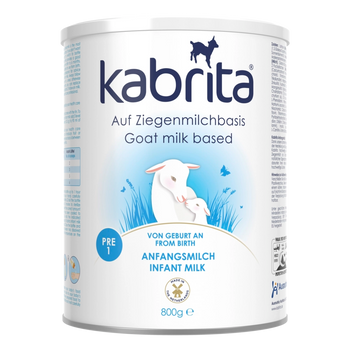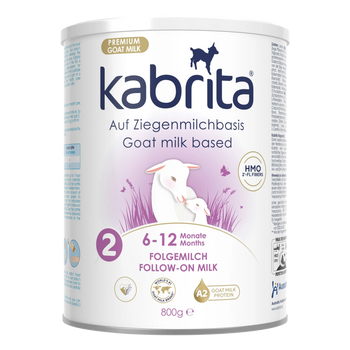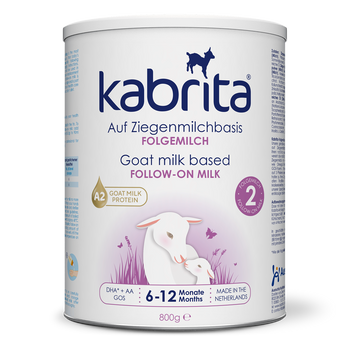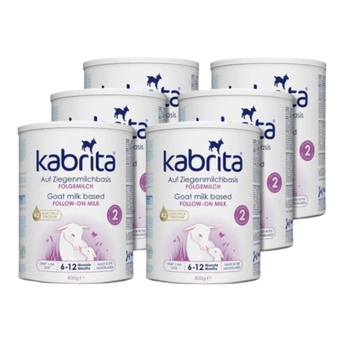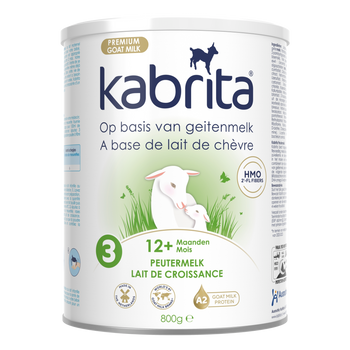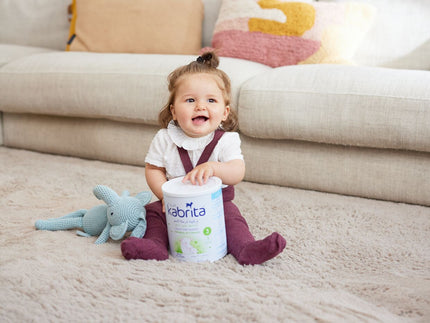Introducing solid foods to your baby: A helpful guide

You’ve likely been practicing with occasional solid snacks between meals over the past few months. But now that your baby is 6 months or older, you can officially start introducing solid foods. What exactly should your baby eat each day, and how much formula should you continue to give? To help you out, we’ve created a handy feeding schedule for your baby at 6, 7, and 8 months old.
When is my baby ready for solid foods?
For the first six months, your baby generally gets all the necessary nutrients from breast milk or formula. Between four to six months, you can start letting your baby try solid foods. Here are some signs that your baby might be ready for solids:
- Your baby's appetite increases
- Your baby watches you curiously while you are eating
- Your baby no longer has the reflex to push food out of the mouth with the tongue
- Your baby can sit upright (with support).
- Your baby can hold her head upright and turn towards or away from food
- Your baby opens her mouth herself when you offer a spoon with food
Which foods to start with
One bread meal can be replaced with porridge, but don't do this too often. Eating bread helps develop the muscles in the mouth, which is important for speech development. Since a baby’s digestive system is still developing, it’s best to start with porridge made from a single grain, and only after your baby is 4 months old.
Porridge made from a single grain can be mixed with breast milk or formula to create a familiar taste for your little one. Begin gradually by adding just a small amount of porridge to the milk, making a slightly thickened mixture. As your baby becomes accustomed to swallowing solid food, you can slowly increase the amount of porridge to create a thicker consistency.
Preferably feed porridge with a spoon rather than a bottle, as this slower process gives your baby's digestive system more time to process it, reducing the risk of stomach pain. Rice porridge is a good starting option because it’s easy to digest. However, don’t offer it every day (as recommended by the Dutch Nutrition Centre). After your baby is accustomed, you can switch to coarser types like wheat or oatmeal porridge.
Starting with vegetables
Pureed vegetables are a great way to introduce solid foods. Start with mild vegetable flavors like pureed sweet potatoes, peas, pumpkin, broccoli, or carrots. Gradually introduce more vegetables with stronger, more bitter tastes, as it may take longer for your child to get used to them.
Begin with fruit purees a bit later, such as banana, peach, mango, and pear, which are naturally sweet and appealing to your baby. Research shows that children who start with vegetable purees and are frequently offered them tend to eat more vegetables later in life¹. Tip: For an even smoother texture, you can add a little breast milk or formula to the puree at first.
Start by letting your baby taste something new once a day, at a convenient time when your baby isn’t tired or cranky. Your baby may not eat much at first, but give them time to get used to it and gain experience. Begin with a bottle or breastfeeding, and then offer one or two teaspoons of pureed solid food.
Some babies need to practice holding food in their mouths and swallowing. As your baby starts eating more (around 8 months), you can gradually add other foods like bread, potatoes, rice, and protein sources like meat, fish, eggs, or plant-based alternatives (without added salt or sugar).
Tips for introducing solid foods
These tips will make introducing solid food to your baby’s diet easier.
Choose the right moment: When you think your baby is ready to try solid food, don’t start when your baby is hungry. Wait until your baby is fully awake and in a good mood before you start.
Puree the food for easy swallowing: Your baby will need to learn how to swallow and chew solid food, so make sure the food is pureed into a smooth consistency. If you want, you can make the food even smoother by adding a bit of breast milk or formula to the puree.
Offer food without forcing: Your baby will eat only when ready. Place a small amount on the tip of a spoon and offer it to your baby. If your baby is interested, they’ll open their mouth and move toward the food. Don’t force the spoon between their lips.
Take your time: Some babies enjoy solid food right away, while others need more time. If your baby refuses to eat solid food, try again calmly a few days later.
Expand slowly: Start with mild flavors and offer one flavor at a time. After a few days, you can gradually introduce different types of vegetables and later fruits. This allows your baby to experience various flavors. Between 6 and 8 months, gradually increase the number of solid food meals. Around the 7th month, you can also begin offering foods with different textures, such as mashed or chunky purees.
Additional tips for the feeding schedule
Some babies might struggle with eating vegetables in the first few days. It’s helpful to start as early as possible (from 4 months, but not earlier) with offering various vegetables for proper taste development.
Solid food is a new experience for your baby and their digestive system. Since a baby’s colon is still developing, it’s best to start with pureed vegetables and later introduce fruits, potatoes, meats, fish, and grains (for more information, see the Dutch Nutrition Centre).
Making eating vegetables enjoyable is important for learning to enjoy them. Make mealtime fun if your baby is hesitant to eat. Use a fun spoon, sing a song, use a pretty plate, or shape the food in a fun way—be creative.
Another helpful tip is to set a good example. Babies tend to mimic you. If you eat healthily, your baby is likely to follow, as they learn by watching. For more tips and information, see the Dutch Nutrition Centre.
The Rapley method for babies
With the Rapley method, you offer your child pieces of food that they can pick up and feed themselves, rather than pureed food. The principle of the Rapley method is that your child is in control, just like with breastfeeding or bottle-feeding. Your baby decides the amount and the pace. When transitioning to solid foods, discovering new flavors, shapes, and textures is key.
It’s important to always stay close in case your baby chokes. For more information on the Rapley method, see the Dutch Nutrition Centre and the Consumers' Association.
Babies discover the world around them primarily by copying behavior. By letting your baby control the pace and amount of food, they can explore food, gain confidence, and enjoy eating. Your baby must learn to eat through play.
Never force your baby to eat more. This new (warm) meal with solid food is extra, so don’t reduce the amount of bottle or breastfeeding yet.
Vitamin D & K
A healthy diet includes the necessary vitamins. For baby and child nutrition, there are legal requirements for the amount of vitamins that must be present. You often hear that your baby needs extra vitamin D and vitamin K.
Vitamin D is essential for building strong bones and for normal growth and development.
Vitamin D is produced in our skin under the influence of sunlight and is also found in breast milk and formula. Even though the formula contains vitamin D, the Health Council advises giving extra vitamin D to children and anyone with a tinted or dark skin tone to ensure they get enough. Until the age of 4, your child needs an additional 10 µg of vitamin D per day (see Consumers' Association).
________________________________________
¹ Barends C, de Vries JH, Mojet J, de Graaf C. Effects of starting weaning exclusively with vegetables on vegetable intake at the age of 12 and 23 months. Appetite. 2014 Oct;81:193-9.
de Wild, V., de Graaf, C. and Jager, G. (2015), Strategies to promote vegetable intake. Pediatric Obesity, 10: 205-212. https://doi.org/10.1111/ijpo.244
